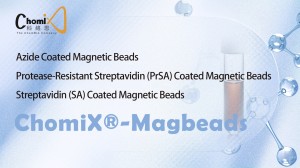-

ChomiX-Magbeads Azide Coated Magnetic Beads
ChomiXR-Magbeads Azide Coated Magnetic Beads are designed by covalently attaching an azide bioorthogonal group to the surface of the magnetic beads. Through non-cleavable ligation group (Figure A) and cleavable ligation group (Figure B)respectively, these beads can be applied to the enrichment of alkyne-modified macromolecules, including proteins, nucleic acids, antibodies and sugars. Over streptavidin (SA) coated magnetic beads, ChomiXR-Magbeads Azide Coated Magnetic Beads have the following advantages:
1. Through the efficient “click chemistry” reaction, the alkyne-modified macromolecules can be directly covalently bound to the magnetic beads, unlike the non-covalent and reversible interaction between streptavidin and biotin. Therefore, the product has higher recovery rate and better repeatability.
2. As there is no protein on the surface of the magnetic beads, the background peptide contamination due to enzymatic digestion will not be introduced. Furthermore, these beads reduce the non-specific adsorption to make samples cleaner, helping to improve the identification efficiency of low-abundance proteins.
3. Chemical molecular modified magnetic beads are stable, making them easier to transport and store.
4. Cleavable azide magnetic beads enable the mild release (using formic acid) of the peptides modified by the chemical probe, which is beneficial for the subsequent mass spectrometry identification.
5. The product is cost-effective, and improves experimental efficiency since it avoids streptavidin-biotin enrichment time.
-

ChomiX-Magbeads Protease-resistant Streptavidin (prSA) Coated Magnetic Beads
ChomiXR-Magbeads Protease-resistant Streptavidin (prSA) Coated Magnetic Beads are designed with chemically modified streptavidin, where lysine and arginine residues are chemically sealed. This modification does not affect beads binding to biotinylated proteins while preventing enzymatic degradation by Trypsin and LysC proteases. In mass spectrometry-based proteomics studies, Trypsin and LysC proteases are frequently used for protein digestion. To avoid sample loss, researchers directly perform on-bead enzymatic digestion in streptavidin magnetic bead systems loaded with biotinylated proteins.
However, this enzymatic digestion process also generates a large amount of streptavidin-derived peptides, which seriously interfere with the detection of low abundance peptides in subsequent mass spectrometry analysis.
Therefore, the development of ChomiXR-Magbeads Protease-resistant Streptavidin (prSA) Coated Magnetic Beads can greatly reduce this interference, which is highly suitable for direct enzymatic digestion of biotinylated proteins loaded on magnetic beads, and can be widely used in chemical proteomics and protein-protein interaction experiments in cells such as APEX and BioID.
The beads have a concentration of 10 mg/ml and a particle size of 1.0 μ m, with high streptavidin loading capacity(approximately 50 μ g / 1mg ) and extremely high hydrophilicity. Their superparamagnetic properties guarantee rapid magnetic response. They also possess excellent redispersion stability and magnetic stability, effectively ensuring high protein binding rate, low non-specific adsorption, reaction uniformity and detection consistency.
-
ChomiX-Magbeads Streptavidin (SA) Coated Magnetic Beads
ChomiXR-Magbeads Streptavidin (SA) Coated Magnetic Beads, based on the strong binding ability between streptavidin and biotin (kd = 10-14~ -15 mol/L), can highly specific bind with biotinylated proteins or antibodies. They are one of the important tools in the field of life science, widely used in protein separation and enrichment, immunodiagnosis and cell sorting. The beads have a concentration of 10 mg/ml and particle size of 1.0 μ m, with high streptavidin binding capacity(about 50 μ g / 1mg ) and extremely high hydrophilicity. They also exhibit superparamagnetic properties, rapid magnetic response, excellent redispersion stability and magnetic stability, effectively ensuring a high protein binding rate, minimal non-specific adsorption, reaction uniformity, and detection consistency.

